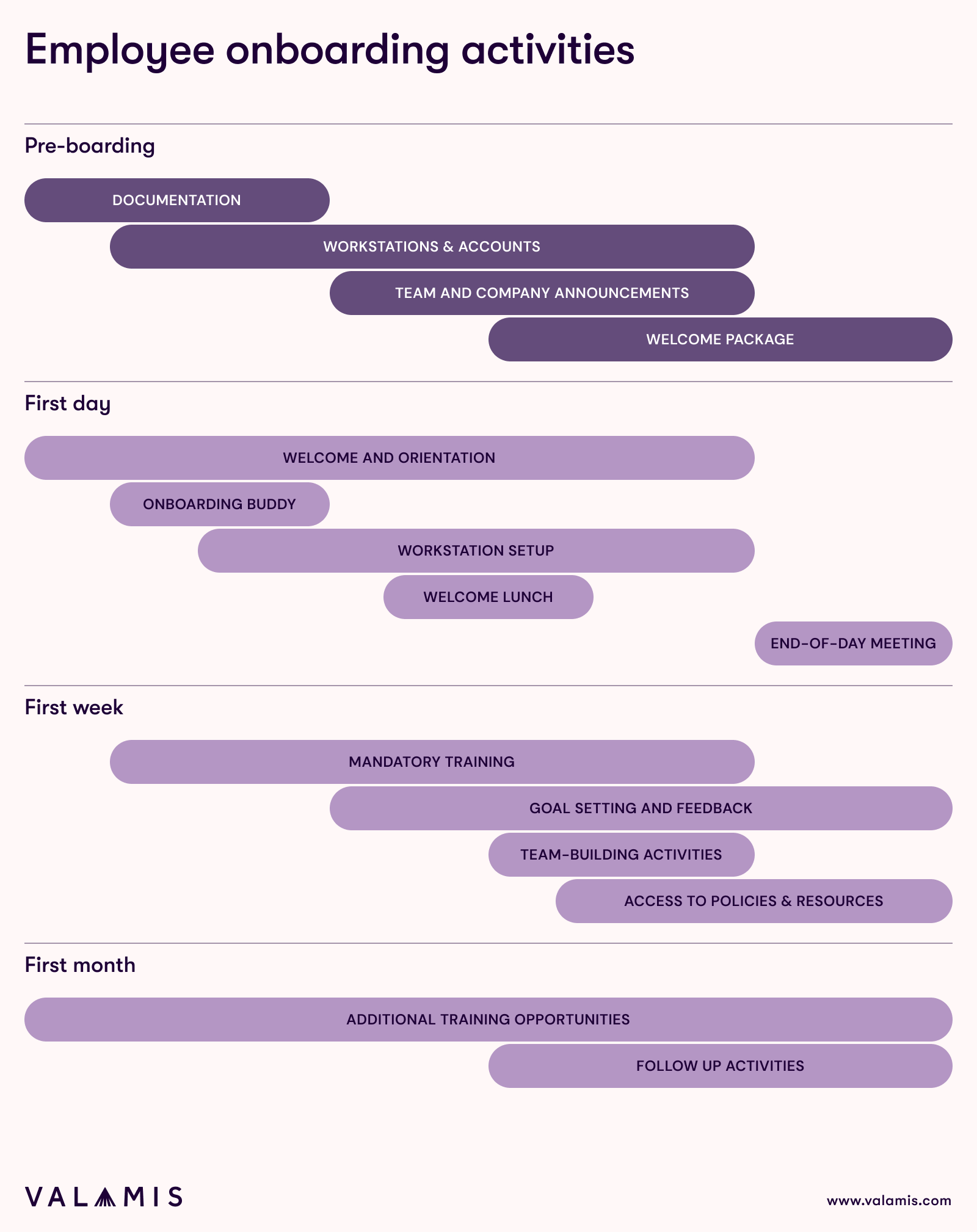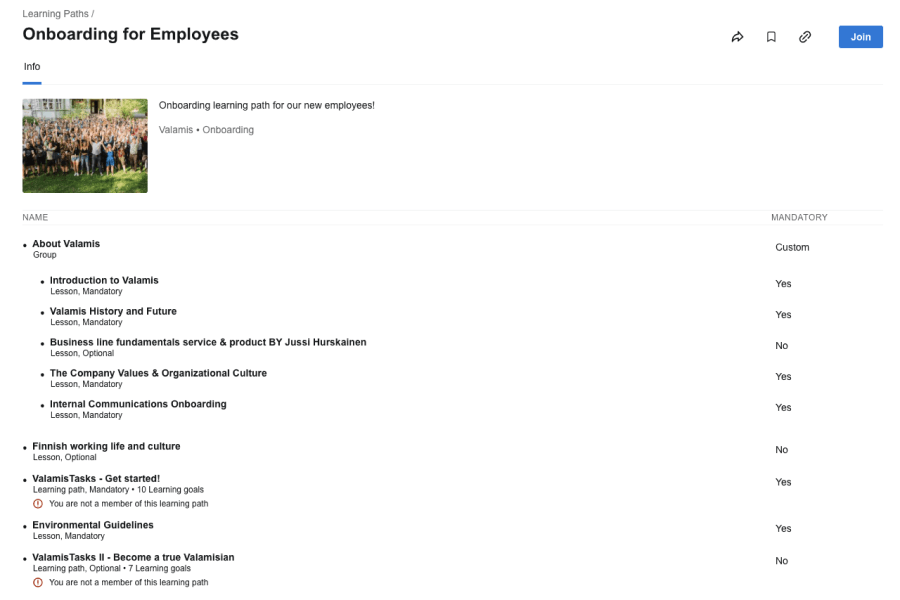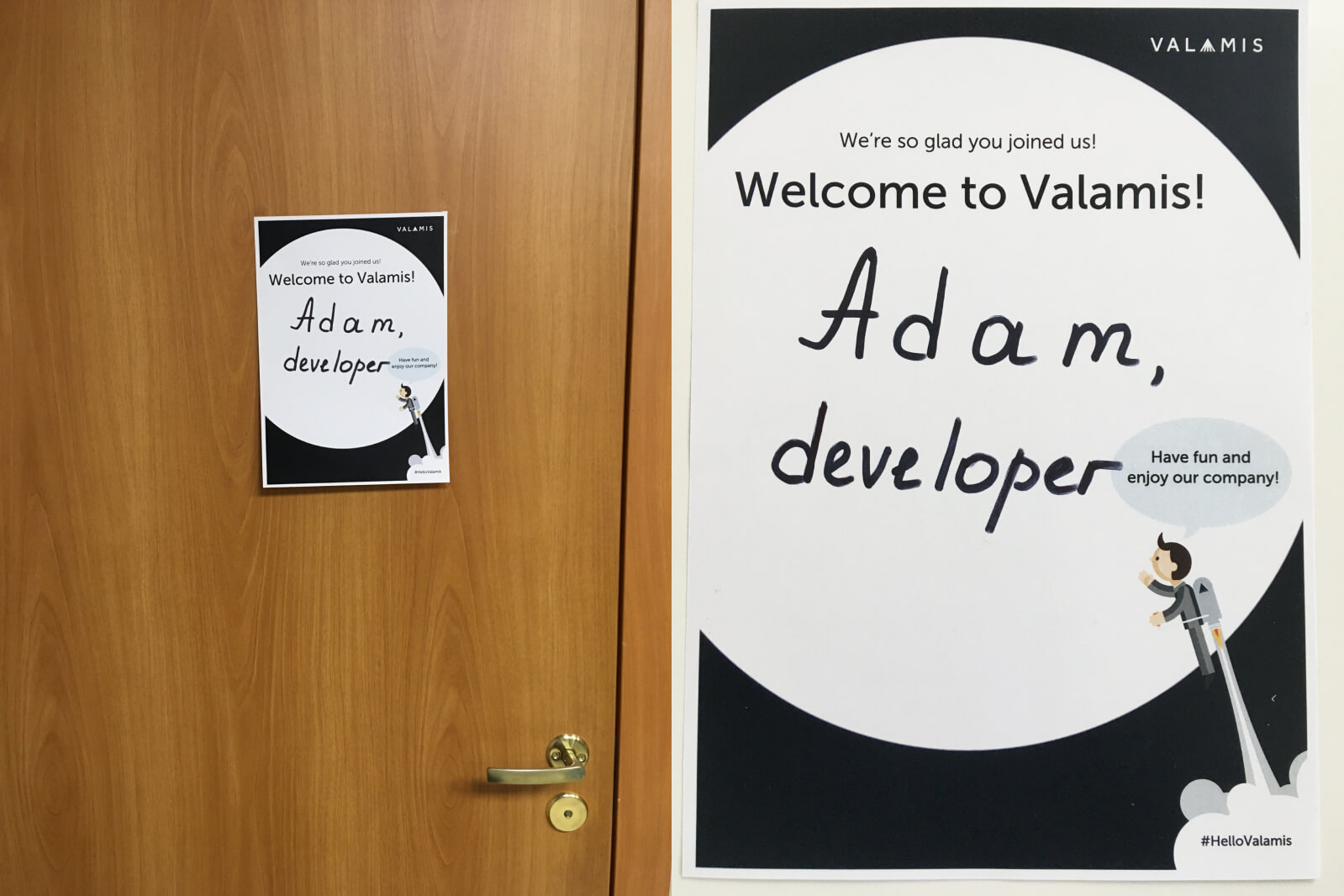Employee onboarding process
Learn what employee onboarding is and how to organize the process. Discover best practices for each step from pre-onboarding till the end of the orientation.

After reading this guide you will know what a good onboarding process can bring to your organization and how you can improve your organization’s current process.
Learning more about onboarding process will help you create a better learning path for employees, find potential skill gaps, improve employee development, and will ultimately allow you to create better teams.
Discover:
- What is the employee onboarding?
- Benefits of properly set employee onboarding process
- How long does it take to onboard a new employee?
- Employee onboarding process stages
- How much does it cost to onboard a new employee?
- Remote onboarding tips
- Best employee onboarding tools
- FAQ about onboarding process
What is the employee onboarding?
Employee onboarding is the process of integrating a new employee into your organization, familiarizing them with your company culture, policies, procedures, and their specific role. This crucial phase sets the tone for their tenure, ensuring they feel welcomed, prepared, and equipped to contribute effectively from day one.
Employee onboarding goes beyond a simple introduction.
It encompasses everything from initial paperwork and orientation to training and social integration. By effectively onboarding your new hires, you help them understand their responsibilities, connect with colleagues, and align with your company’s goals and values.
This process is essential for boosting employee engagement, satisfaction, and long-term retention.

Onboarding checklist in PDF and Excel formats
Ensure a smooth and effective onboarding process for your new hires and set them up for success.
DownloadBenefits of properly set employee onboarding process
1. Acclimatise the employee in the briefest period possible
When the employee is brought in, they need to be taught not only where to park and where the best lunch spots are, but also what is expected from them.
They should know where to find support within their peers and management team, and exactly what they can expect from the company.
Setting clear expectations allows your employee to understand their role from day one.
2. Decrease the time it takes for your new employee to become productive
The better the onboarding process, the quicker your new employee will be able to settle down to work and begin being productive.
If you have an inefficient or confusing program, your employee will waste their first few weeks having to ask questions that they should already know the answers to.
Set them up for success with clear onboarding materials that answer all the questions they may ask about their role or the company.
3. Properly engage the employee
Engaged employees increase productivity, profitability, and product quality, among other positive outcomes.
Engagement in this context means that the management team is showing that they value the employee, recognize their talents, and are committed to fostering their professional growth.
53% of HR professionals say that better onboarding creates engaged employees, which then carries over to their career within the company.
An organisation’s onboarding is the first look an employee has at the structure, politics, and support within the company.
You should strive to make sure that it is a positive experience.
4. Good onboarding programs directly improve employee retention
About ⅓ of employee turnover happens during the first 90 days.
This is attributed to poor onboarding and organizations who leave their employees to ‘fend for themselves’ and ‘sink or swim’ mindsets.
Costs associated with replacing an employee can be as much as 150% of their annual salary. This includes hidden costs such as decreased productivity, the loss of special knowledge and a reduction in morale among remaining staff.
Employee retention can save the company thousands of dollars.
5. A good onboarding process will promote a better company culture
By setting the tone from the first day, you build a strong culture within your company of employees being valued, taught, and supported.
New employees immediately understand and feel welcomed by the company, and existing employees see that the workforce is valued.
Specific company values are communicated clearly.
How long does it take to onboard a new employee?
Onboarding can vary significantly depending on the role and company.
On average, it takes about 90 days to onboard a new employee effectively.
However, a comprehensive onboarding process can extend up to a year, ensuring they are fully integrated and productive.
Detailed employee onboarding process flow

Pre-boarding: first impression and recruitment
Pre-boarding is the process that takes place between a candidate accepting a job offer and their first official day of work.
The onboarding process starts when a potential candidate first encounters your job application or gains an impression of your company elsewhere.
Your employer branding actions, including job applications, are designed to support your onboarding process.
When drafting job applications, attract top candidates while showcasing your company as an excellent place to work.
Clearly outline the role’s expectations and the skills of your ideal candidate, but also highlight why your organization is a great place to be.
During recruitment, your HR team posts about open roles, reviews applications, interviews top candidates, and ultimately offers the job to the most qualified individual.
Negotiations may occur before the job offer is accepted.
Goals for pre-boarding stage
- Attract relevant candidates who share your values and bring necessary skills.
- Clearly communicate the expectations for each role.Clearly communicate the expectations for each role.
- Create a positive impression and leave potential candidates with a clear understanding of your company.
Best practices
1. Create a company culture page on your website.
Use this page to show your working culture, the people of your organization, and their values.

2. Review first touchpoints.
Review all your assets that might be first touchpoints for a potential candidate.
It can be your website, social media, the company page on a job website, and so on.
Update them, and make sure they fit your company brand. Look at clarity, consistency and tone.
3. Ensure job listings are inclusive.
Review job listings and interview questions using the same criteria as above.
- Are your listings inclusive?
- Do they represent your company well, and will they attract the people you want?
- Is there room for improvement?
4. Transparency in policies.
Have a policy of transparency in regards to policies that impact your employees.
Policies around maternal or paternal leave, working remotely, vacation time, bonuses, or expected weekly hours should be clearly communicated and easily accessible.
5. Send an official offer letter.
This should clearly outline the top-level responsibilities of the role, as well as all requirements and expectations.
This is where you can make sure that everything about the role is communicated clearly, and there will be no unpleasant surprises.
This doesn’t have to be an extra formal letter, though! Let the personality of your organization shine through, include information about the team, their pets and hobbies, or other fun facts about the company.
6. Set up their IT equipment and access credentials.
After the job has been offered, set up an office tour, if possible, and begin the onboarding process by giving access to the company training portal, company email account, and all other details.
7. Inform relevant stakeholders
Schedule their first-day agenda and notify relevant team members.
Liaise will all relevant stakeholders about the new hire, their role in the onboarding plan and allocate resources for training.
Everyone should know their responsibilities, which include developing the itinerary for the new employee’s first week, setting goals, assigning an onboarding buddy and clearly laying out the path to success for this person.

Onboarding checklist in PDF and Excel formats
Ensure a smooth and effective onboarding process for your new hires and set them up for success.
DownloadOnboarding on the first day: welcoming and introduction
The first day of onboarding is all about making your new employee feel comfortable and welcomed. Here’s how you can achieve this:
Goals for the first day
- Make your new employee comfortable and welcomed from the first moment.
- Provide a positive introduction to new colleagues and the workplace.
- Establish the expectations for the new role with the employee. As the new employee is introduced to their team, clarify each person’s role and how they will be interacting as a team going forward.
Best practices
1. Personal welcome.
An HR person should welcome the new employee, show them to their workstation, and deliver all necessities including office keys, equipment, codes, badges, and passwords.
2. Introduction to key software.
Provide introductions to key software programs and a tour of the office.
3. Learning Management System (LMS) introduction.
If you have an LMS, introduce it and ensure there’s a mandatory learning path covering company essentials.
This can effectively cover important topics about the company, including products, key people, organizational history, and more.

Employee onboarding learning path inside Valamis learning environment.
4. Welcome poster.
This is a nice gesture to welcome a new colleague.
Print a Welcome poster with the name and title of the new hire. Attach it to the office main door (outside of course).
This is a really simple way to pay attention to the new employee(s) and also an easy way to show other colleagues that they should welcome their new co-worker on their first day.

Valamis welcome poster
5. Create a welcome package.
When a new employee starts, put a small package at their table.
This gift might include some brand-related material, for example, a mug, beanie, shirt, beer, candies or similar.
It’s a great idea to make a personalized mug, with the new employee’s name on it, their starting date and a personalized slogan. Choosing the slogan might be one of the tasks to do in the onboarding process.

Example of welcome package
6. Welcome coffee.
Organize a welcome coffee, and invite all office employees to participate. You can even order a cake or some sweets.
This creates a great experience and opens up the team to get to know each other, allowing them to tell something about themselves and learn more about each other.
Come up with a list of simple get-to-know-you questions and prompts to help move things along smoothly.
If you have a lot of new employees coming in the near future, you can combine their welcome coffees and do them once a week or over several weeks, or you can limit participants to within the new hire’s department.

Welcome coffee at Valamis
7. Workstation setup.
Set up the new hire’s workstation and organise it.
Make sure that their dedicated space is ready for them first thing. This includes a computer with everything installed and a list of all usernames and passwords, printed items, such as employee guides and codes of conduct, and a list of employees.
Provide them with the information that they need so they know who to ask if they need something else for their job, for example, Barbara in IT can fix their connection, while Adam in HR can help with login issues.

The new hire’s workstation.
8. Assign an onboarding buddy.
This is a person who is assigned to help on the first days. This is their go-to person to turn to when they inevitably have questions throughout their first few weeks.
This is ideally someone on their team who has a solid idea of what their role is, can answer questions easily, and can help smooth their transition.
9. One-on-one meetings.
Set aside 30 minutes at the beginning of the day and 30 minutes in the end for one-on-one meetings with the new hire. This will give them space to ask questions, make observations and ensure that they are on the right track.
10. Social welcome.
If possible, take the new employee out for lunch, create a coffee and cake meet-and-greet or other social function specifically to welcome the new employee.
They should feel as though their new job is as excited to have them as they are to start.
11. Feedback and observation.
Ask a new employee to observe the organization and ask them to tell if they find something to improve. A new person always has a fresh view.
Onboarding on the first week: integration and learning
The first week is crucial for integrating the new employee into their role and the company culture.
Arrange meetings with colleagues they’ll work closely with and key people within the organization. Schedule meetings with department heads and, if possible, one-on-one meetings with team members. A meeting with the CEO, preferably during lunch for a relaxed atmosphere, can make the new employee feel valued.
Each person should teach the new hire different aspects of their role and answer general questions about the company, technology, products, and more.
Goals for the first week
- Introduce the new hire to colleagues and key stakeholders.
- Develop an understanding of their goals and responsibilities.
- Ensure they undergo necessary training and start contributing to smaller tasks.
Best practices
1. Set the support team and start tasks in advance.
All of this should be settled before the new hire starts.
Being organized will demonstrate to the new hire that your company is stable, thoughtful, and takes the time to do things right. It gives a positive first impression.
2. Be realistic about what you expect the new hire to accomplish.
Anticipate that your new hire will take some time to settle in.
Be realistic about what you expect them to do, and communicate that early and often. Discuss the goals and how you will help the new hire reach them.
3. Peer introduction.
If possible, introduce the new hire to someone who has worked in their role.
If that person was promoted out of the role, they will be able to share valuable insights about the growth potential of the company, best practices for fulfilling the role, and in general, will be a key person for the new hire to meet.
4. One-on-one sessions with team members.
Set one-on-one sessions with team members, if possible, so they can tell the new hire more about what they are doing and introduce themselves.
They can explain how the new employee can help them in their work, and be part of really important work at the very beginning of their journey.
Onboarding during 1 month: continuous support and socialization
As your new hire settles in, provide ample opportunities to socialize, learn, develop, and integrate into the company.
This can include large events like company-wide ping pong tournaments or BBQs, or smaller gatherings like coffee with colleagues or one-on-one meetings with supervisors.
Regularly check in with the new hire, follow up with their team and supervisor, and ensure they have all the resources they need, especially at the one-month mark.
A useful tool for a 30-day check-in is a survey. Consider asking questions like:
- Do you feel like a valued part of the company?
- Is the company meeting your expectations?
- Are you experiencing any difficulties with our technologies or tools?
- Do you feel you have the necessary tools and resources?
- Have you outlined your goals with your supervisor?
- Are you making progress toward your goals?
- Do you know the company’s strategic goals for the future?
- Do you have any suggestions to improve our onboarding process?
Goals for the 1st month
- Make sure that your employee is on the path to success within your company by offering continued support, development opportunities and check-ins with relevant team members.
- Foster a community culture within your organization through team-building and one-on-one exercises.
- See how the organization’s onboarding can be improved.
Best practices
1. Regular check-ins.
Supervisors should establish a regular schedule for checking in with the new hire. Goals, current and upcoming projects, and concerns should be addressed in these sessions.
2. Virtual meet-and-greets.
Use technology like Slack’s Donut integration to assist with connecting random team members for virtual meet and greets.
3. End-of-week meetings.
Have one-on-one sessions with the supervisor or department head at the end of each week. This serves to touch base, make sure that things are going smoothly, and all questions or concerns can be quickly addressed.
4. Trial period meeting.
If you have a trial period in your company, set a one-on-one meeting with a supervisor after it has passed. There should also be a survey so that the HR department can learn more about overall results and employee satisfaction.
5. Variety of activities.
Create a variety of activities, so that all employees can find something for them: yoga, exercise, painting, cooking, or sports. Have a variety of different challenges and invite new employees to participate.

Cooking event: It’s better to become friends with the Head of Design during the first month.
6. Don’t stop onboarding after one month.
Continue to monitor your new hire’s journey with your company, develop their talents and invest in them. Consider doing 3 month, 6 month, and 1-year check-ins.
How much does it cost to onboard a new employee?
Onboarding costs can vary from company to compnay from industry to intustry. Usually it includes recruitment expenses, training materials, administrative costs, and time invested by current staff.
On average, you might spend between $4,000 and $7,000 per new hire.
Investing in a robust onboarding process can significantly reduce turnover rates and improve overall employee satisfaction, yielding long-term savings.
However, you can significantly reduce these costs by using an LMS:
- An LMS allows you to create and reuse standardized training materials, reducing the need for repeated live training sessions.
- Training materials can be easily scaled and accessed by multiple new hires simultaneously, reducing the cost per employee.
- Automating tasks such as compliance training, tracking progress, and issuing certificates saves time and reduces administrative costs.
- An LMS provides 24/7 access to training materials, allowing new hires to learn at their own pace and reducing the need for additional resources.
- Digitalizing onboarding paperwork through an LMS reduces printing and administrative costs.
See how Valamis can make your onboarding smooth and easy.
Remote onboarding tips
As more organizations embrace remote work, onboarding can present unique challenges.
Meeting new colleagues, receiving direct training, and asking questions can be more difficult in a virtual environment.
However, with some creativity, you can make remote onboarding just as effective as in-person onboarding. Here are some tips to help:
- Make sure that all of the necessary equipment has been delivered to your new hire and that they have been able to set it up. Schedule a session with an IT person a few days before they are due to log in the first time so that any issues can be found and solved before their official first day.
- Keep in mind that endless video meetings will drain a new employee. Break their schedule up with hour-long meetings followed by an hour of tasks. First-day tasks could be getting familiar with new platforms, setting up Slack, Google Drive and email, or logging into the company LMS and taking the first course. Repeat throughout the day. Set longer or more complex tasks as the onboarding continues.
- Introduce the new employee to team members in 1:1 calls, where the team member is tasked with teaching them part of their new role. Each person can offer a unique insight into the company processes and will break up the day a bit.
- Consider recording training sessions, so that the new employee can refer back to it later on. This helps them feel like they don’t have to be laser-focused 100% of the time, and they know that they won’t miss anything important.
- Don’t forget to celebrate accomplishments! Make announcements in the company-wide chat, send little gifts to team members who have gone above and beyond, reach out personally to thank people for their effort. It’s really important to foster a sense of connection in a time when so many people feel disconnected.
Best employee onboarding tools
Effective onboarding requires the right tools to ensure a smooth transition for new hires.
Leveraging these tools can help streamline the process, enhance communication, and provide comprehensive training. Here are some of the best tools to consider for optimizing your employee onboarding experience.
- Learning Management Systems (LMS): Deliver training content and track progress. LMS can simplify onboarding by providing structured learning paths that cover essential company information and role-specific training.
- Onboarding checklists: Ensure all necessary steps are completed.
- Video conferencing software: Facilitate virtual orientations and meetings.
- Document management systems: Provide easy access to necessary paperwork. At Valamis we use SharePoint.
- Task management tools: Assign and monitor onboarding tasks. At Valamis we use Monday for the purpose.
- Surveys and feedback tools: Gather new hire feedback and improve the process.
FAQ about onboarding process
How long is the onboarding process?
According to this survey, onboarding programs tend to be from one day to one month long. In fact, more than 50% of onboarding programs last one week or less.
This is not ideal – in a perfect world onboarding would take at least 90 to 100 days, and could even go up to a year.
What do new hires want from onboarding?
New hires want to come in and be able to contribute quickly. They want to learn their role, their closest colleagues and know who they can turn to for help.
They also want to have a clearly defined role, a schedule created for them that they can follow the first week or two, and clear communication.
Is onboarding part of recruitment?
It is! Onboarding starts the minute that someone becomes aware of your organization, especially in relation to a job posting. The impression that you give will stick with the person, so you should strive to make sure it is a good one.
During the recruitment stage, it is especially important to cover some of the first steps of onboarding, so potential employees know what to expect from your organization. If you have a good onboarding program, you will find that it is easier to recruit quality employees.
Is onboarding the same as training?
Onboarding and training often go hand in hand, but they are different things.
Training is about teaching new skills to a person and has to do with the tasks the new hire is expected to perform.
Onboarding is about bringing a new person into the culture of the company, integrating them in with the staff, the management and the overall environment.
Does orientation count as the start date?
It can, depending on when it happens, before the starting day or on the first day.
Some organizations choose to have an orientation session before the official start date, others have the two on the same day.
What is the difference between a new hire orientation and onboarding?
A new hire orientation is a one-time event, usually on the first day, where new employees are formally introduced to the company values, ethos, leaders, policies and administrative procedures.
Onboarding is a much longer process, which does include orientation, and is where the new hire is introduced to all aspects of their new role. This usually includes job training, goal-setting, introduction to company culture, meeting other employees and serves to help the new hire get adjusted quickly and become productive.

Onboarding checklist in PDF and Excel formats
Ensure a smooth and effective onboarding process for your new hires and set them up for success.
Download



